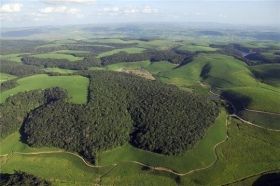Nitrate deposits in the Arctic remains high even after the turn of the century, despite environmental policies adopted by neighboring countries in the late 20th century to cut nitrogen oxide (NOx) emissions.
articles
No plastics left behind: study confirms plastic beach debris a danger to ocean life
At current rates of plastic production, by 2050 the total mass of plastics in our oceans will outweigh the biomass of fish. — World Economic Forum
Deforestation in the Tropics
Tropical forests around the world play a key role in the global carbon cycle and harbour more than half of the species worldwide. However, increases in land use during the past decades caused unprecedented losses of tropical forest. Scientists at the Helmholtz Centre for Environmental Research (UFZ) have adapted a method from physics to mathematically describe the fragmentation of tropical forests. In the scientific journal Nature, they explain how this allows to model and understand the fragmentation of forests on a global scale. They found that forest fragmentation in all three continents is close to a critical point beyond which fragment number will strongly increase. This will have severe consequences for biodiversity and carbon storage.
First Nations communities lift water advisories with simple treatment system
For the first time in decades, two remote First Nations communities in Lytton, B.C. have access to safe drinking water – thanks to a point-of-entry treatment system designed by University of British Columbia engineers in collaboration with the communities, industry and government.
Stanford Scientists Eavesdrop on Volcanic Rumblings to Forecast Eruptions
A new study has shown that monitoring inaudible low frequencies called infrasound produced by a type of active volcano could improve the forecasting of significant, potentially deadly eruptions.
NASA Sees Tropical Cyclone Gita Weakening
NASA-NOAA’s Suomi NPP satellite and the GPM core satellite passed over Tropical Cyclone Gita is it began weakening from vertical wind shear.










